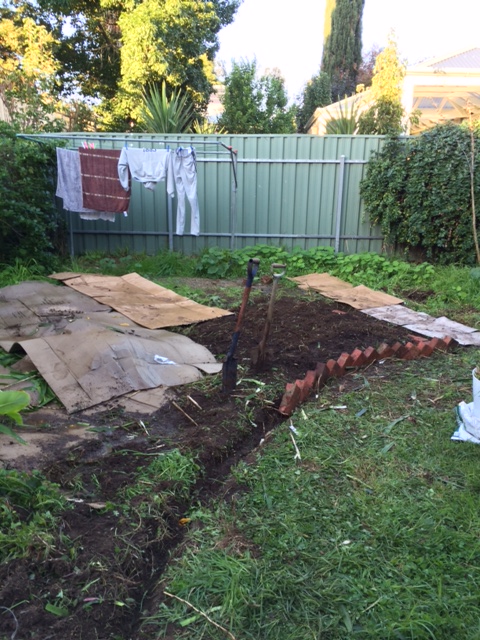I was quick to start digging soil at my new place. Perhaps this was at the expense of more considered observation. However, time was not on my side – I wanted to get a winter crop in and make the yard look a little more presentable. One factor I was very observant of, though, was solar access. My kitchen garden had to be in a sunny part of the yard. So I spent a week or so monitoring the suns movement through the sky – tricky when you’re at work at day – to determine in which part of the yard I would concentrate my planting. Initially, I was thinking quite close to the house. However, it soon became evident that there wouldn’t be enough sun. Scrap that. Instead, the area I selected was right up against the back fence – as far from the backdoor as you can get.
As I won’t have to do much watering during the short days of winter this will not pose any problems. Any maintenance can be done at the weekends – for there isn’t enough daylight for me to spend much time working on the garden during the week. And come spring, the days will be longer and it will be a more pleasant place to be later in the day.
But what about herbs? I have planted a few varieties in the main beds. They’re doing really well. However, what are the chances of me trudging through the mud at 6pm on a Wednesday night to harvest chives to enhance the evening meal? Very slim indeed. Bland omelettes it will be. Or will it?
This scenario illustrates the logic behind zone planning. Zone planning, according to Mollison “means placing elements according to how much we use them or how often we need to service them” (Mollison, 2011). Well my kitchen garden satisfies that. I need to access it about as much as it needs me to pay it attention. In most situations, the kitchen garden is situated in Zone 2/3. The house – the centre of activity – is Zone 0. Which means there is a Zone 1 somewhere. Perhaps this is where my herbs can go? Mollison says yes. “Zone 1 is close to the house. It is the most controlled and intensively-used area and can contain the garden, workshops, greenhouse and propagation frames…” Deep Green Permaculture is more specific: “Elements that are located in this zone include all the things that you need to access most often, or that need the most frequent attention, such as… a kitchen garden to provide vegetables and salad greens which have a short growing season (time from planting to harvest) and herbs for teas and culinary use…”
But how am I going to locate my herbs in Zone 1 if there is insufficient sun? I put my observation goggles on…
Turns out, just to the right of the backdoor, behind the laundry, the area in front of the rainwater tank gets several hours of sun a day. It is also a nice little microclimate due to the sun heating up the metal of the rainwater tank which then radiates onto the concrete before it. A perfect place for herbs. But in pots they will have to go.
Next on my list was compost. At the moment I am relying on the trench composting method – dig a hole or trench and bury your scraps. This is helping me build soil in an area I intend to expand the kitchen garden come springtime. But again, this isn’t ideal. The area I have been ‘trenching’ is right up the back too. So I don’t take out the compost every day. Much to the annoyance of my partner. But it’s cold and wet and muddy…
Having a regular compost heap or bin in Zone 1 wouldn’t be ideal. So a worm farm is the answer. Deep Green Permaculture is with me on this. Worm farms are a more agreeable method of composting kitchen scraps in Zone 1, especially if the area also acts as your outdoor entertainment area as it does for me, for they are clean, relatively odourless, compact and, dare I say, novel. So they can easily be placed at or near the backdoor. Encouraging you to use it often rather than letting your kitchen tidy bin or bucket become smelly. So that’s the next thing on my list to make – a worm farm.
Until then, some photos of the progress:

This is the brassica bed. Loads of winter veg with some lettuce and silverbeet growing strong. And some radish starting to germinate.

The beginning of my little Zone 1 herb garden. Pots have been chosen for obvious reason – it’s concrete. However, this is the right response to my observations. For the alternative would have been to place the herbs in a section of garden bed that simply doesn’t get enough sun.
Mollison, B. & Slay, R. M. (2011). “Introduction to Permaculture” (Second Ed.). Tagari Publications, Sisters Creek, Tasmania.



